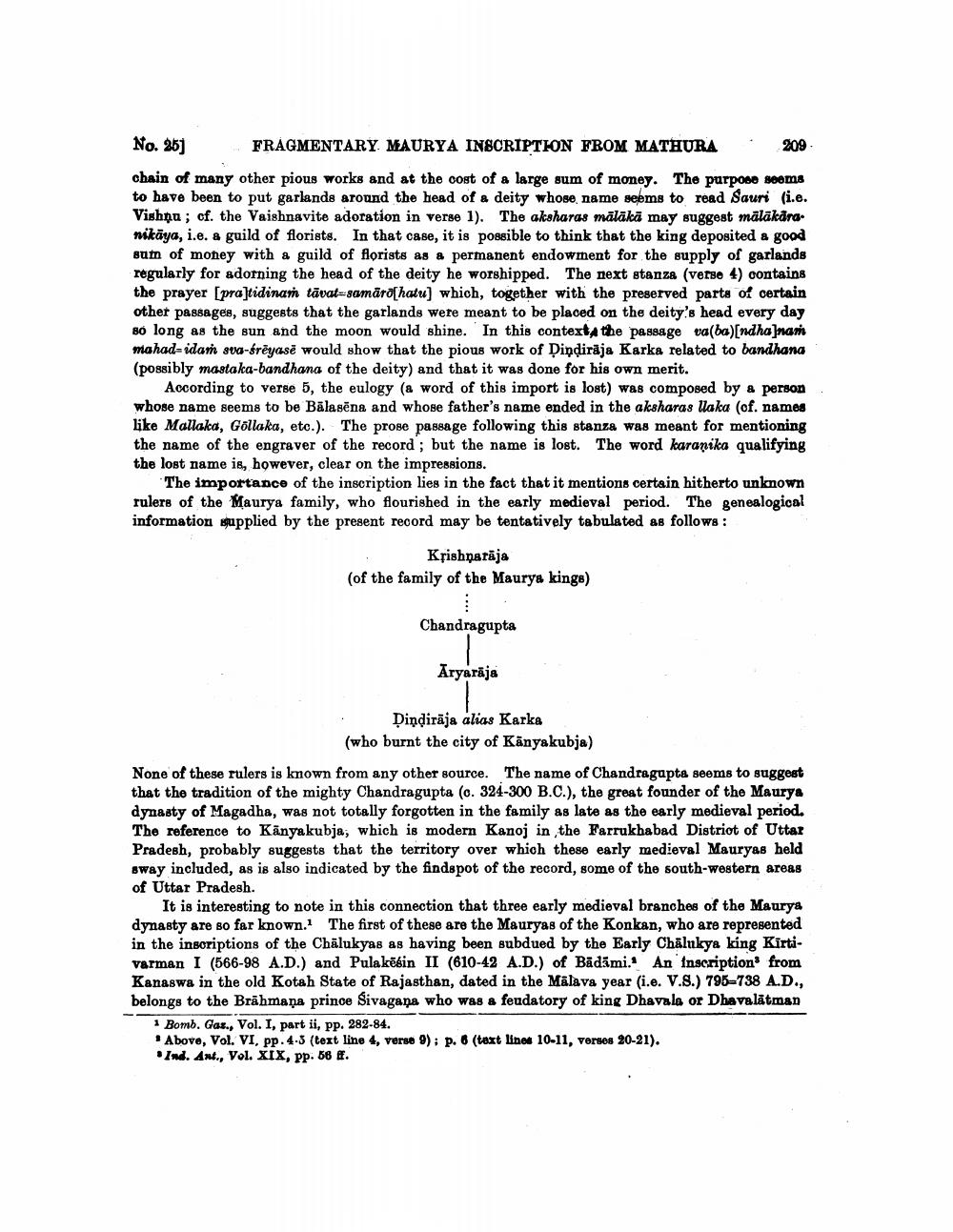________________
No. 261
FRAGMENTARY. MAURYA INSCRIPTION FROM MATHURA
209
chain of many other pious works and at the cost of a large sum of money. The purpose seems to have been to put garlands around the head of a deity whose name seems to read Sauri (i.e. Vishnu ; cf. the Vaishnavite adoration in verse 1). The aksharas mālākā may suggest mälākára mikāya, i.e. & guild of florists. In that case, it is possible to think that the king deposited & good out of money with a guild of florists as a permanent endowment for the supply of garlands regularly for adorning the head of the deity he worshipped. The next stanza (verse 4) contains the prayer pratidinan tāvat samāro hatu) which, together with the preserved parts of certain other passages, suggests that the garlands were meant to be placed on the deity's head every day so long as the sun and the moon would shine. In this context the passage va(ba)[ndhanam mahad=idam sua-śreyasē would show that the pious work of Dindirāja Karka related to bandhana (possibly mastaka-bandhana of the deity) and that it was done for his own merit.
According to verse 5, the eulogy (a word of this import is lost) was composed by a person whose name seems to be Bāla sēna and whose father's name ended in the aksharas llaka (of. names like Mallaka, Göllaka, etc.). The prose passage following this stanza was meant for mentioning the name of the engraver of the record ; but the name is lost. The word karanika qualifying the lost name is, however, clear on the impressions.
The importance of the inscription lies in the fact that it mentions certain hitherto unknown rulers of the Maurya family, who flourished in the early medieval period. The genealogical information supplied by the present record may be tentatively tabulated as follows:
Krishnarāja (of the family of the Maurya kings)
Chandragupta
Aryarāja
Dindirāja alias Karka
(who burnt the city of Kānyakubja) None of these rulers is known from any other source. The name of Chandragupta seems to suggest that the tradition of the mighty Chandragupta (c. 324-300 B.C.), the great founder of the Maurya dynasty of Magadha, was not totally forgotten in the family as late as the early medieval period. The reference to Känyakubja, which is modern Kanoj in the Farrukhabad Distriot of Uttar Pradesh, probably suggests that the territory over which these early medieval Mauryas held sway included, as is also indicated by the findspot of the record, some of the south-western areas of Uttar Pradesh.
It is interesting to note in this connection that three early medieval branches of the Maurya dynasty are so far known. The first of these are the Mauryas of the Konkan, who are represented in the inscriptions of the Chālukyas as having been subdued by the Early Chālnkya king Kīrtivarman I (566-98 A.D.) and Pulakësin II (610-42 A.D.) of Bädāmi. An Inscription from Kanaswa in the old Kotah State of Rajasthan, dated in the Malava year (i.e. V.S.) 795-738 A.D., belongs to the Brāhmaṇa prince Sivagana who was a feudatory of king Dhavala or Dhavalātman
1 Bomb. Gas., Vol. I, part ii, pp. 282-84. * Above, Vol. VI, pp.4.3 (text line 4, verse 9); p. 6 (text line 10-11, verses 20-21). Ind. Ant., Vol. XIX, pp. 58 .




